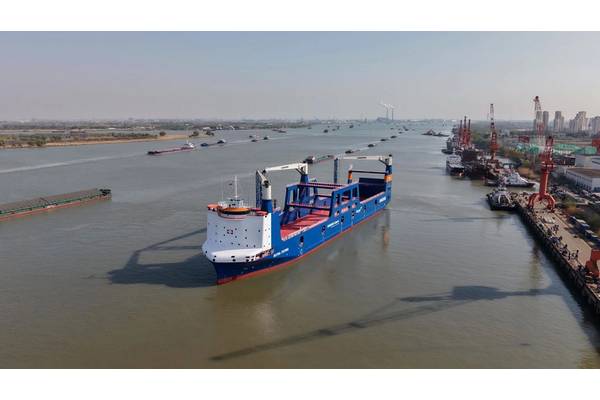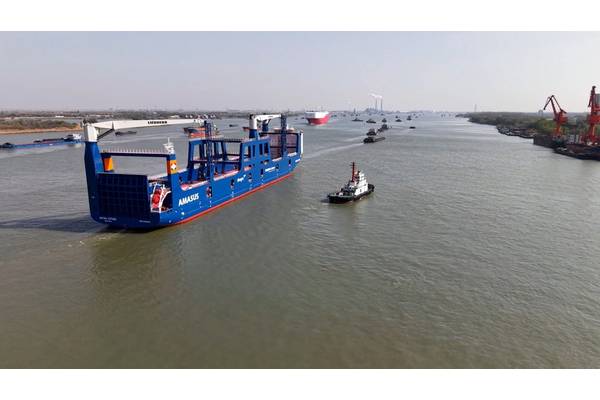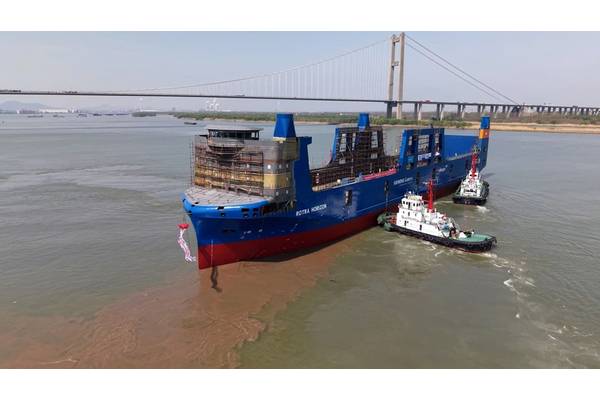



Danish logistics specialist deugro and its partners Siemens Gamesa Renewable Energy A/S and Amasus Offshore B.V. are moving full steam ahead with the next generation of purpose-built transport vessels for the offshore wind sector. In a key milestone for offshore project logistics, the Rotra Futura was delivered on March 30, 2025, and just four days later, her sister ship Rotra Horizon was launched from Zhenjiang Shipyards in Jiangsu Province, China. The Rotra Horizon is slated for delivery in July 2025.
The delivery and launch represent a significant expansion of the “Rotra concept,” a pioneering vessel design and logistics model first introduced in 2016 to meet the specialized transport needs of the offshore wind industry. The concept was born from a collaboration between deugro—a long-established project logistics provider—and Siemens Gamesa, a leading player in global wind energy. Together with vessel operator Amasus Offshore, the partners are pushing the envelope on maritime efficiency, operational flexibility, and emissions reduction.
The new vessels are the culmination of more than a decade of cooperation.
The original Rotra Mare and Rotra Vente, which debuted in 2016 and were later reconfigured in 2022, have together transported more than 7.8 million freight tonnes of offshore wind components. That total corresponds to over 9 gigawatts of installed offshore capacity. Both original vessels remain in active operation, supporting Siemens Gamesa’s ongoing global rollout of offshore wind farms.
Now, Rotra Futura and Rotra Horizon are poised to extend that legacy, designed from the keel up to meet the increasing scale of next-generation offshore turbines. Each measures 167.6 meters in length with a beam of 26 meters. Bridge and accommodations are located forward to maximize deck space and cargo intake without line-of-sight limitations—a crucial design consideration for safely loading increasingly large and delicate components.
“These newbuilds have been tailored to match the evolving size and weight of offshore wind turbine components,” said Christian Johansen, Global Commodity Manager for Ports & Transportation at Siemens Gamesa. “With our offshore order backlog now exceeding 16 GW, this added capacity ensures we can meet global demand while maintaining safety, reliability, and cost-efficiency.”
Both vessels feature an integrated roll-on/roll-off (RO/RO) ramp, three Liebherr cranes, and a gantry system allowing for three-tier blade stowage. This unique configuration enhances flexibility in cargo composition and enables the simultaneous transport of varying component types—key for modular wind farm construction.
Under the hood, Rotra Futura and Rotra Horizon are also built for environmental performance. The optimized hull form, combined with low-drag coatings and fuel-efficient Wärtsilä engines, results in a 15% reduction in fuel consumption compared to industry norms. The ships are outfitted with hybrid propulsion systems, exhaust gas cleaning compliant with IMO Tier III standards, and waste heat recovery technology—elements that reflect a broader push to decarbonize maritime logistics.
“Driving sustainability in offshore logistics isn’t just about reducing emissions—it’s about rethinking how we move cargo from the drawing board,” said Anders Moeller, Country Manager Denmark for deugro. “Our trilateral Rotra vessel collaboration, rooted in mutual respect and innovative thinking, shows how the shipping industry can lead the energy transition.”
While Rotra Futura has now officially joined the global fleet, her ceremonial naming will take place in Europe later this year, underscoring the project’s transcontinental scope. With both ships expected to enter full operation by mid-2025, deugro and its partners are reaffirming their role in shaping the future of offshore wind logistics—one shipment at a time.
 The launch of the Rotra Horizon at Zhenjiang Shipyards, Zhenjiang, Jiangsu, China. Image courtesy deugro
The launch of the Rotra Horizon at Zhenjiang Shipyards, Zhenjiang, Jiangsu, China. Image courtesy deugro